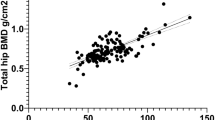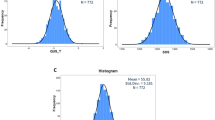Abstract.
Osteoporosis is a common complication in children with chronic rheumatic diseases (CRD). Although dual energy X-ray absorptiometry (DXA) is increasingly being used to determine bone mineral density (BMD) in children, it exposes the subject to ionizing radiation and does not provide a measure of true bone density; in fact, in growing bones the increase in BMD is mainly caused by the increase in bone size. In recent years, quantitative ultrasound techniques (QUS) have been used in radiation-free assessment of bone density and ``bone quality'' by measurement of the ultrasound waves attenuation by bone (BUA). In the present study we made a direct comparison of BUA in the calcaneum, determined by the pediatric contact ultrasound bone analyzer (CUBA) with lumbar BMD measured by DXA, in a group of 6–18-year-old patients with CRD. The study group consisted of 53 patients affected with juvenile rheumatoid arthritis (n = 29), systemic lupus erythematosus (n = 13), and juvenile dermatomyositis (n = 11). Mean age was 13.02 ± 2.69 years. In 22 patients (19 girls, 3 boys) both DXA and CUBA were repeated after 1 year in order to assess the mean percentage rate of BMD and BUA change over this time. Both lumbar spine BMD and calcaneal BUA measurements were lower in the CRD patients compared with a control group (P < 0.001). Calcaneal BUA was significantly correlated (r = 0.83, P < 0.001) with lumbar spine BMD. Age and sex correction (Z-score) did not change the relationship between BUA and BMD (r = 0.80, P < 0.001). A significant correlation between the mean percentage of variation (Δ%) of BMD and BUA (r = 0.76, P < 0.001) was also demonstrated in the 22 patients who were evaluated prospectively. Portability, ease of use, lower cost, and absence of radiation make CUBA a promising means of evaluating BMD in children.
Similar content being viewed by others
Author information
Authors and Affiliations
Additional information
Received: 12 December 1998 / Accepted: 13 January 2000
Rights and permissions
About this article
Cite this article
Falcini, F., Bindi, G., Ermini, M. et al. Comparison of Quantitative Calcaneal Ultrasound and Dual Energy X-ray Absorptiometry in the Evaluation of Osteoporotic Risk in Children with Chronic Rheumatic Diseases. Calcif Tissue Int 67, 19–23 (2000). https://doi.org/10.1007/s00223001090
Published:
Issue Date:
DOI: https://doi.org/10.1007/s00223001090




